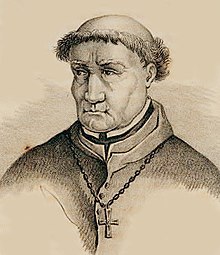ANTI-SEMITES spray-painted the Town Hall of a tiny northern Spanish town this week, but their graffiti made disturbing reference to a Spanish priest now 500 years dead.
‘Torquemada era camarada‘ (‘Torquemada was an ally’) read the black graffiti on sunbaked Spanish brick. To anyone in Spain, the name of Torquemada instantly means cruelty and religious fanaticism in the name of the Catholic church.
Thomas of Torquemada (1420-1498) was an intelligent Dominican Friar of Jewish descent, who became a central figure of religious fervour as the first Grand Inquisitor of the Spanish Inquisition and advocate for expelling Jews from Spain, torturing converts and burning heretics at the stake.
The tiny village of Castrillo Mota de Judios (population 50) is a new focal point for righting Spain’s historic wrongs after residents changed its name from Castrillo Matajudios (‘Camp Kill Jews’) in 2014.
Though the ancient Jewish settlement of Castrillo Mota de Judios will wash these recents stains away, the legend of Torquemada is not so easy to forget.
Who was Thomas of Torquemada?
Tomas de Torquemada was born on 14th October 1420 in the city of Valladolid, the capital of Spain’s Castilla y Leon, to a prestigious family that renowned theologian and confessor to King Juan II, Juan de Torquemada.
Thomas of Torquemada’s ancestry also includes Jewish converts to Christianity, known as conversos, whom religious authorities began to view with increasing suspicion.
At the time of Torquemada’s birth, the Catholic kingdoms of Castilla and Aragon had conquered most of the Spanish peninsular but the Muslim Sultanate of Granada still ruled the south until 1492.
The largest reconquered cities of Barcelona, Sevilla and Valladolid had sizeable Jewish and Muslim populations.
Periodic outbreaks of violence against these communities saw many Jews convert to Christianity for personal safety and to access positions of authority. However, whether conversos converted to the Christian faith or continued practising Judaism became the principal concern of religious authorities.
Torquemada meanwhile was rising up the religious ranks after Queen Isabel I de Castilla named him one of three personal confessors to the crown in 1474.
One of Torquemada’s first jobs was to investigate Jewish practices among conversos in the southern cities of reconquered Spain. In the name of ridding ‘false converts’ to Christianity, the Spanish crown received the pope’s blessing to set up a Court of Inquisition in 1478 and properly oversee public trials of faith.
At first, the Inquisition descended on the Andalucian city of Sevilla in 1481 and burnt alive six Jewish converts.
By 1483, Pope Sixtus VI named Torquemada as the first Inquisitor General de España (Spanish General Inquisitor), and he held the post with zeal until his death in 1498.
Accounts say that Torquemada forced Jews who had converted out of fear of retaliation to wear garments that marked them as condemned souls, bearing images of hell’s flames, dragons and snakes.
Spanish historians estimate the Inquisition burned alive over 10,000 people during Torquemada’s reign.
In 1832, just two years before the end of the Spanish Inquisition, gravediggers exhumed his body and burnt it just like Torquemada had done to thousands of Jews.

Why was the Spanish Inquisition so brutal towards Jewish converts to Christianity?
Religion became the defining culprit of the Spanish Inquisition, but the roots of anti-semitism in 15th century Spain are much harder to define.
Some accounts say rural Spaniards accused Jews of having a hand in the Black Death of 1347, either poisoning wells or trying to rid Spain of Christianity.
Others factors were pure jealousy.
A prime example can be found in Alonso Cota, the treasurer of Toledo until 1449 when the mayor of this central Spanish city rose up against Cota before ransacking, burning and murdering converts in the Jewish quarter la Magdalena.
Cota was a prominent Jewish convert to Christianity of high intelligence and authority in Toledo.
When the King of Castilla, Juan II, wanted to raise funds for a war against the Crown of Aragón, he asked for an outrageous loan from Toledo and ordered mayor Pedro Sarmiento to take up arms against Alonso Cota and his possessions.
Cota narrowly survived the slaughter.
This pattern of events was seen prior to the nationwide pogroms of 1391, which began in circumstances surrounding the assassination of José Pichón, a senior treasurer in Sevilla and extremely wealthy Jewish convert.
The significant difference in 1449, however, was the subsequent decree of ‘blood-cleansing statutes’ that dispossessed Jewish converts of their positions of authority and wealth in favour of Catholics who could prove their Catholic heritage.
By 1492, mistrust, jealousy and hatred of Jewish converts led to a decree expelling all practising Jews from Spain. A similar series of events happened with Muslim converts to Christianity and the expulsion of Moriscos in 1609.
How has Spain apologised to Spanish Jews?
Pope John Paul II began making the first apologies for the atrocities of the Spanish Inquisition in 2000.
In 2011, the president of Mallorca made the first official apology for the role of the Spanish government in the Inquisition and the persecution and murder of Jewish converts.
The central Spanish government in 2015 then began making amends for the expulsion of Jews in 1492, when Torquemada was still chief Inquisitor.
The government passed a law recognising descendents of Sephardic Jews following their expulsion from Spain, opening a legal path for them to apply for Spanish citizen and return home up to 500 years later.
By 2019, more than 127,000 Sephardic Jews from Mexico, Venezuela, Argentina the US and Israel applied for citizenship.
Read More
